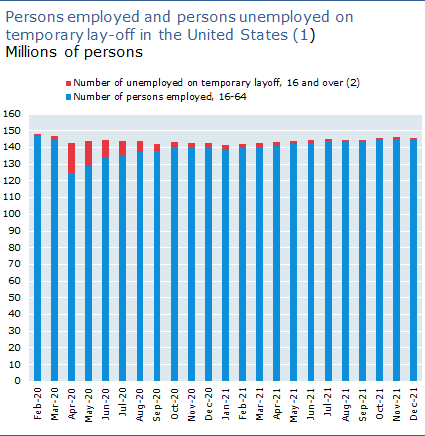The employment rate in the OECD area continues to rise in Q3 2021, reaching 68%
25 Jan 2022 – The OECD area employment rate, which is the percentage share of the working-age population with jobs, rose to 68.0% in the third quarter of 2021, from 67.4% in the second quarter. The rise in the OECD area employment rate occurred alongside an increase in the labour force participation rate – the share of the working-age population that is either employed or unemployed – to 72.5%, up from 72.2% in the second quarter.
The OECD area employment rate rose at broadly the same pace for women (to 60.8%, from 60.2% in the second quarter) and men (to 75.3%, from 74.7%), as well as among young people aged 15-24 (to 41.6%, from 40.9%), people aged 25-54 (to 77.9%, from 77.3%) and those aged 55-64 (to 61.7%, from 61.1%).
Increases in the employment rate were reported in 35 out of 37 OECD countries for which data is available, with a decrease registered in Australia (down to 74.8%, from 75.4% in the second quarter) and a stable employment rate in Finland (72.7% in both the second and third quarter).
The employment rate rose by 0.7 percentage point, to 68.4%, in the euro area as a whole. It increased by 1.4 percentage points in Canada (to 73.8%), by 0.8 percentage point in the United States (to 69.8%, still 1.9 percentage points below the pre-pandemic rate), by 0.4 percentage point in Korea (to 66.8%) and Mexico (to 61.5%), by 0.3 percentage point in the United Kingdom (to 75.4%), and by 0.2 percentage point in Japan (to 77.9%). More recent data for the fourth quarter of 2021 show that employment rates increased further in the United States (to 70.5%) and Canada (to 74.8%).
In the third quarter, the largest increases in the employment rate were recorded in Chile (to 59.2%, from 57.3%), Colombia (to 61.5%, from 59.6%), Costa Rica (to 58.3%, from 55.6%) and Ireland (to 71.1%, from 69.1%). However, Chile, Colombia and Costa Rica are also the countries for which the gap to pre-pandemic rates (recorded in the fourth quarter of 2019) is the highest.
In the third quarter, employment rates were above pre-pandemic levels in Australia, France, Greece, Hungary, New Zealand and Portugal.1
| |
Break in time series for the euro area between Q4 2020 and Q1 2021 resulting from . This break also affects, to some extent, aggregates for the OECD-Total. A large part of the increase in the employment rate for the OECD-Total in the third quarter of 2020 and, to a lesser extent, fourth quarter of 2020 reflects the return to work of furloughed workers in Canada and the United States, where they are recorded as unemployed, whereas in most other countries, they are recorded as employed. – Source: Quarterly Labour Market Statistics, OECD | (1) This chart provides a more comparable view of movements in US employment statistics with movements in most other OECD countries, where furloughed workers are included in official employment statistics. It should however not be interpreted as alternative official statistics for the United States. In this chart, the number of employed covers age group from 16 to 64, while the number of unemployed on temporary lay-off covers age group 16 and over. (2) US Current Population Survey data. |
European countries showing a break in their employment series reflecting methodological changes in the EU Labour Force Survey in the first quarter of 2021 are necessarily excluded from this list.








